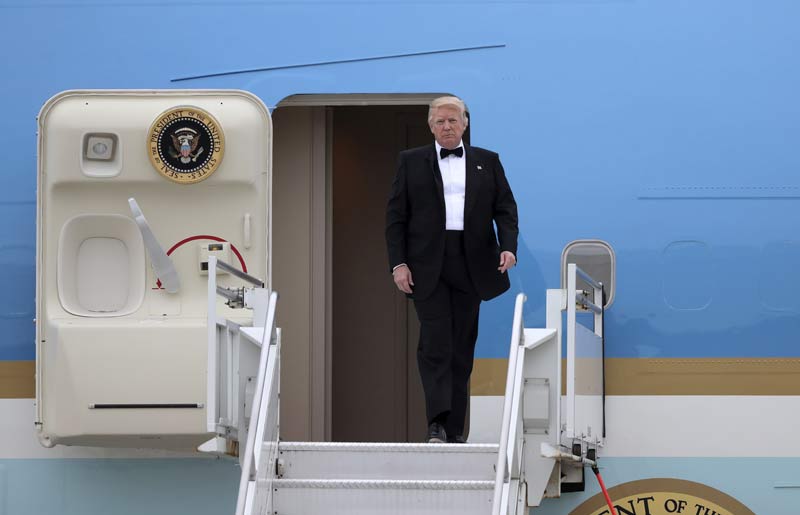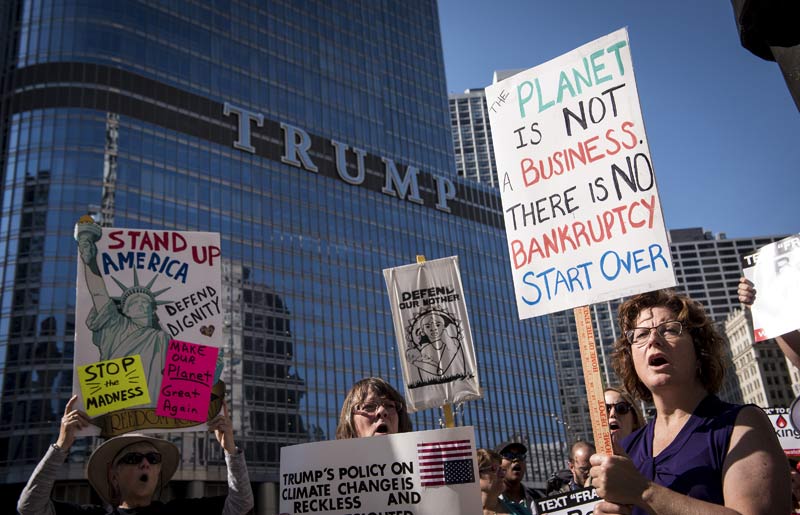US President Donald Trump’s announcement in June that the world’s second-biggest greenhouse gas emitter was to withdraw from the 2015 Paris Agreement on climate change may have been no great surprise, although it was certainly disappointing to many. But inasmuch as Trump has underscored his credentials as climate-change sceptic-in-chief, he has also cast a shadow over whether the country will uphold other environmental commitments made under the previous administration.
In the case of aviation, that shadow hangs over ICAO’s bid to tackle air transport emissions through its Carbon Offsetting and Reduction Scheme for International Aviation (CORSIA). Former president Barack Obama agreed last year that the USA would be an early participant in CORSIA, which is voluntary for the first six years. A total of 70 nations have so far agreed to participate in the initial phase of the scheme.

Few were surprised by Trump's move to pull out of the Paris Agreement
Xinhua News Agency/REX/Shutterstock
The Paris Agreement and CORSIA are two separate agreements, and the hope at ICAO and in the aviation industry is that US airlines will still participate in the global offsetting scheme. However, the Trump administration has yet to offer any clarification on what its course of action might be.
Speaking at the recent IATA annual general meeting in Cancun, Mexico, the association’s director-general, Alexandre de Juniac, said: “Let me reassure you that the disappointing decision of the US to back out of the Paris Agreement is not a setback for CORSIA.
“They are completely separate agreements. The alternative to CORSIA is a patchwork of measures that would be ineffective, costly and unmanageable. Our membership remains united behind CORSIA and our climate change goals.”
The Air Transport Action Group (ATAG) says of CORSIA that it is “very much hoping and encouraging the US to stay in”, and notes that “we have had no indication otherwise from the US administration”. One of the key differences between the Paris Agreement and CORSIA, adds ATAG, is that the latter is “fully supported by the industry, US airlines included”.
Despite the uncertainty over US participation, ICAO is working to address the remaining sticking points and ensure that its timeline for implementing CORSIA remains on track.
Michael Gill, IATA environment director and executive director of ATAG, says two key areas of the scheme still need to be ironed out: the monitoring, reporting and verification system, and the criteria of eligibility of emission offsets. Consensus is growing around what these rules will look like, says Gill, and “hopefully by the end of 2017 we will have a clearer idea of how the final rules are going to look”.
Progress on developing CORSIA since it was agreed at ICAO’s 39th assembly last autumn has been “positive”, says Gill, and a global seminar in Montreal in May – which followed a series of regional seminars on the scheme throughout April – proved to be “a very productive meeting”.
“From an industry perspective, where we’ve attended all the regional seminars, it was good to see the feedback from the global seminar. Feedback was positive – states are no longer asking why we’re doing it, they’re asking how it can be implemented,” says Gill.
But while the general mood is positive, he adds that “there is a lot of capacity building still to be done”.
One area of concern highlighted by some environmentalists is the integrity of the type of emissions-reduction projects that airlines would be investing in to offset their emissions. Pointing to a report released by the European Commission in April, which alleged that 85% of the offset projects under the UN’s Clean Development Mechanism (CDM) had failed to reduce emissions, Brussels-based campaign group Transport & Environment says it is worried that the aviation sector risks repeating the same mistakes through CORSIA.
The report, prepared for the European Commission’s Directorate-General for Climate Action (DG Clima) by Germany’s Institute for Applied Ecology, found that the majority of the CDM projects in its analysis had “a low likelihood” of ensuring that emission reductions were additional and not over-estimated. According to the report, just 2% of the projects it examined had a high likelihood of resulting in concrete emission reductions.
“Our analysis suggests that the CDM still has fundamental flaws in terms of overall environmental integrity. It is likely that the large majority of the projects registered and CERs [Certified Emissions Reductions] issued under the CDM are not providing real, measurable and additional emission reductions,” the report says.
Andrew Murphy, aviation manager at Transport & Environment, wants to see exactly which credits airlines are buying to offset their emissions, and is concerned that not all credits will have environmental integrity. “I fear that the primary goal of CORSIA is to have as broad a range as possible of credits and you could end up with bad offset credits getting in there.
“It’s all well and good for a developed country to buy offsets from a developing country because they have no [emissions reduction] targets, but after Paris they’ll have targets.”
Gill says he is “aware of concerns about the validity of CDM”, but points out that the United Nations Framework Convention on Climate Change (UNFCCC) is working on a new standard that should correct the failures of CDM. “We have to trust in the UNFCCC to improve on any weaknesses there may have been,” says Gill. He adds that while airlines “should get access to as wide a range as possible of units”, more important is “wide access to genuinely credible units that meet strong sustainability criteria”.
“We don’t want to endorse a system where there are concerns about eligibility,” says Gill.
But aside from worries about the quality of the offset credits purchased by airlines, Murphy does not believe CORSIA goes far enough to address rising emissions from the global airline industry. “It’s not good enough for the aviation industry to keep emitting and purchasing emissions reductions from someone else. It’s not enough to just move the numbers around between sectors – everyone needs to reduce emissions,” he says.
Murphy expects negotiations on the final rules governing CORSIA to be “very tough”, reflecting the complexity of how carbon markets work.
As ICAO and other stakeholders finalise the details of the new carbon-offsetting scheme, IATA is urging all airlines to prepare for it, regardless of whether or not their home state has volunteered to take part in the initial phase. “We’re hoping to increase awareness at airlines across the world that every airline operating international flights will have to prepare for CORSIA,” says Gill. “When CORSIA comes into effect in 2021, for states that don’t volunteer [in the initial six years when the scheme is voluntary] there is a misconception at a number of airlines that they can put it off for a number of years.”
But, he stresses, this is not the case. “In January 2019 every airline operating international flights will have to monitor and report their CO2 emissions,” he says. This means airlines will have to submit a plan at the end of 2018, detailing how they will monitor their fuel use and provide the results to their national authorities.
IATA has put together a checklist of actions that airlines should be taking to prepare for CORSIA. The key actions include designating a person or department within each airline to focus on CORSIA; taking part in IATA-organised webinars and training sessions over the coming 18 months; and becoming familiar with fuel measurement and emissions reporting methods.
In the first half of next year, IATA is urging airlines to identify any gaps in their resources for dealing with CORSIA, to ensure their data collection systems are fit to handle data flows under the scheme, and to identify the correct point of contact at their national authority.
The second half of 2018 will require the submission of each airline’s emissions monitoring plan and the selection of an external verification agency, ahead of 1 January 2019 – the point from which emissions will be monitored to establish a baseline for CORSIA.

Admiration for the US administration's stance on climate change is not universal
USA/REX/Shutterstock
“The fundamental message is: even if your state hasn’t volunteered, if you’re an airline flying internationally you will have to prepare,” says Gill. “Be aware this is coming, be aware of the timeframe, make sure you’ve got someone in charge of it and that you’re in touch with IATA to get the most up-to-the-minute information.”
AIRLINES FEAR EUROPEAN DOUBLE JEOPARDY ON EMISSIONS-COUNTING
One key question when it comes to regulating future aviation emissions is whether the European Union’s Emissions Trading System (EU ETS) will still apply to airlines from 2021, when ICAO’s new Carbon Offsetting and Reduction Scheme for International Aviation (CORSIA) comes into effect.
In February the European Commission proposed that its current “stop the clock” strategy – which excludes aircraft emissions that occur outside the European Economic Area (EEA) from taking part in the ETS – remains in place in the run-up to CORSIA’s implementation.
However, the Commission says it will carry out a further review on whether to continue including aviation in its ETS in the post-2020 period, “once there is more clarity about the nature and content of the legal instruments adopted by ICAO for the implementation of [CORSIA], as well as about the intentions of our international partners regarding the implementation of the global market-based measure”.
In other words, it is possible that from 2021 airlines would be expected to participate in both the EU ETS and CORSIA.
This potential outcome is unpalatable to the industry. Michael Gill, IATA environment director and executive director of the Air Transport Action Group (ATAG), says: “Our view is that post-2021, CORSIA should be the single measure. [Anything else] would be duplicative and overlapping.”
He hopes that “once the detailed technical standards of CORSIA have been worked out”, this will “give comfort” to the Commission and so this duplication will be avoided.
But not everyone shares this view. Andrew Murphy, aviation manager at the Brussels-based sustainable transport campaigner Transport & Environment, says that for beyond-Europe flights, “the ideal scenario is to see the two [ETS and CORSIA] interacting at the same time”. He describes the EU ETS as being “four times more ambitious than CORSIA”.
The EU had originally intended to include all intercontinental flights arriving at and departing from its member states’ airports in the EU ETS. However, it agreed in November 2012 to temporarily suspend their inclusion in the scheme, in order to give ICAO a chance to develop a global market-based measure.
Without February’s proposal to continue limiting the scheme to intra-European flights, international aviation emissions would have automatically been reincorporated into the ETS from 2017. The Commission’s proposal to revise the EU ETS will be discussed by the European Parliament and the European Council, and a decision is expected to be finalised by the end of this year.
Source: FlightGlobal.com


























